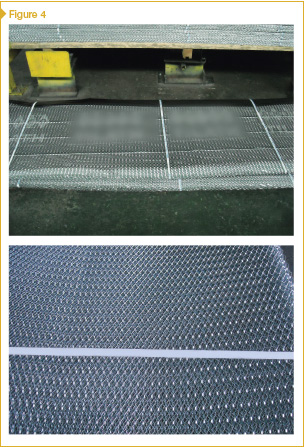
The production of “utility lath” offers manufacturers material savings that, in turn, are offered at reduced prices to attract consumers. To further complicate the lath dealer’s decision process, some of these manufacturers produce “code-compliant lath,” but offered or supplied only when specifically requested and at a premium (or otherwise cost-competitive) price.
Recommendations to avoid inferior lath
Contractors who install stucco or stone systems over sheathed surfaces in accordance with ASTM standards are responsible for submitting and installing lath products that meet the standard. However, stiff pricing competition and deceptive advertising can attract a designer/specifier and contractor to submit, purchase, and install inferior lath. There are various methods that can be implemented to ensure the designer/specifier, lath dealer, and contractor are respectively selecting, submitting, and installing quality products.
The designer is obligated to carefully review the submittal for compliance with the project specifications and referenced standards. In the submittal process, the designer should be cognizant of the various products available in the marketplace to avoid the economic lures and associated performance pitfalls of approving “utility” or “nominal” lath that does not meet the ASTM C847 criteria. Another mechanism that can be used to ensure the supply of proper lath is requiring the manufacturer to provide third-party (e.g. ICC-ES)-accredited laboratory test reports certifying the lath complies with ASTM C847 for the specific project in question.
Typically, tags are attached to the pallet during manufacturing to identify the weight of the lath and its compliance with ASTM C847. However, because these tags can be either damaged or removed during shipping and tend to not make it to the field, traceability is significantly impaired. To avoid confusion and uncertainty in events of missing or damaged tags, manufacturers can implement a packaging method, such as the one shown in Figure 4, which positively identifies the lath from the plant to the jobsite in 10-piece bundles.
This packaging method is growing in popularity and is embraced by manufacturers. Without an appropriate tracking program, building officials must request documentation to validate the lath conforms with the code and applicable standards. However, by implementing the packaging method, building officials can quickly and effectively validate compliance of the lath instead of facing time delays in requesting the supporting documentation.
Whatever method is chosen, the intent is to provide full disclosure to the designer, dealer, and contractor the lath was produced to proper dimensions and weights defined in the ASTM C847-10 standard.
Conclusion
Expanded metal lath, like many other building materials, is under extreme pricing competition in the marketplace. This has resulted in the production, promotion, and marketing of lath that does not necessarily comply with industry standards or the building code with regard to material, geometry, or weight. However, this lath is offered at a discounted price of code-compliant lath, making it attractive to contractors attempting to use a perceived-to-be-acceptable product for a lower cost.
As a result, inferior “utility” or “nominal” lath has been sold and installed in stucco-clad buildings throughout the United States. Design/construction professionals should strongly consider the various measures outlined in this article in order to eliminate the confusion and ensure installation
of appropriate lath.
Christopher K. Little, CDT, CSI, is group product manager of AMICO Building Products, based in Birmingham, Alabama. A 20-year veteran of the building products industry, he has been with AMICO since 2004, providing guidance to manufacturing and installing lath and accessories, stainless steel products, and security products. Little serves on ASTM C11 and C15 committees, American Concrete Institute (ACI) 514 subcommittee on lath and plaster, and National Concrete Masonry Association’s (NCMA’s) Technical Committee on Manufactured Veneer Stone. He is a LEED Green Associate (GA) and writes AMICO’s product sustainability documents. Little can be reached at clittle@gibraltar1.com.
Matthew J. Innocenzi, PE, is a senior associate with WDP & Associates and is primarily involved with forensic investigations of structural/architectural deficiencies. He is a member of the American Institute of Steel Construction (AISC), RCI, and various ASTM International committees. Innocenzi can be reached via e-mail at minnocenzi@wdpa.com.




